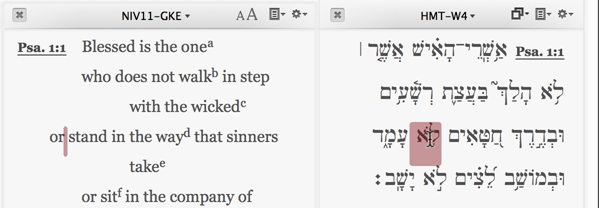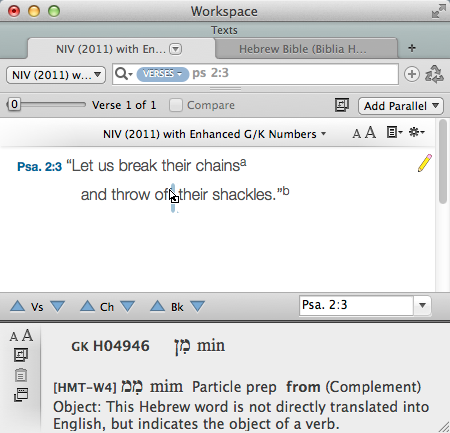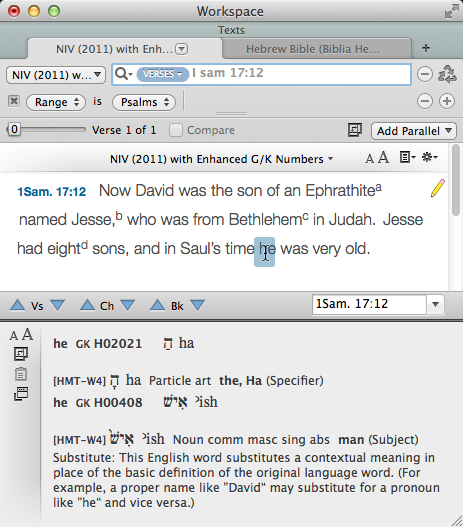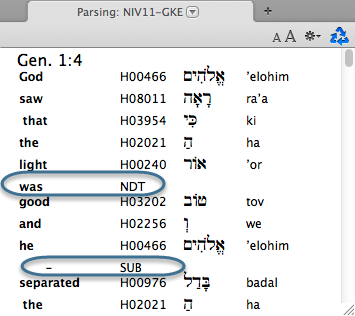Enhanced Text Modules with Phrase Tagging
Several Accordance Text modules![]() Any Bible text, or other single tool that can be read in Accordance, including reference texts and articles; may also be referred to as content or resource feature enhanced phrase tagging. They include:
Any Bible text, or other single tool that can be read in Accordance, including reference texts and articles; may also be referred to as content or resource feature enhanced phrase tagging. They include:
- 2011 New International Version with Goodrick-Kohlenberger Key numbers (NIV11-GKE)
- Mounce Reverse-Interlinear New Testament (MOUNCE-NT)
- Leonberger (NT) mit G/K-Nummern (LEO-NT-GKE)
Enhanced texts feature some additional functionality when viewing the Instant Details, using mouseover highlighting, and more. Click on an item below to view more information about a specific enhancement. The NIV11-GKE is used in the examples below, but the examples apply to all enhanced texts, including the German LEO-NT-GKE.
Mouseover HighlightingMouseover Highlighting
Mousing over a word in a phrase highlights all the words in the phrase. One or more words are fully highlighted as these are words with Key numbers assigned to match the original words. Other words in the phrase are highlighted with lighter colors as these are English helper words, which do not directly correspond with an original word.
Following are a few examples:
Example 1: All words in NIV11-GKE are associated with the Key number for the Hebrew wordExample 1: All words in NIV11-GKE are associated with the Key number for the Hebrew word
In this example, several words are fully highlighted as they have key numbers assigned to match the original words.

Example 2: Helper words in English, not directly corresponding with the Hebrew wordExample 2: Helper words in English, not directly corresponding with the Hebrew word
In this example, all of the words in English that are highlighted are directly associated with the Key number for the Hebrew word.

Example 3: No word in English corresponds with the Hebrew wordExample 3: No word in English corresponds with the Hebrew word
In this example, a blank space is highlighted, indicating that there are no Hebrew words with an English equivalent.

Instant DetailsInstant Details
In addition to displaying the Key numbers, some words are tagged with more information and displayed in the Instant Details.
Not Directly TranslatedNot Directly Translated
Words that are not directly translated appear in bold in the Instant Details, followed by more information, as shown below.

ObjectObject
This indicates that the Hebrew word is not directly translated into English, but indicates the object of a verb.

SubstituteSubstitute
This indicates that the word in English is a substitute for a word, based on the context of the text.

SearchingSearching
|
Note When one Key number is applied to two or more words in a phrase, the number of hits for a search on that Key number will not reflect accurately the number of occurrences of that original word. |
You can search using the following tags:
- [KEY NDT]: This tag searches for all words that are not directly translated. The highlighted hit words
 The verses, words, text, or other information found as the result of a search are words not directly translated into English. The small red flags indicate "missing" words, that is, words that appear in the original text but not in the English.
The verses, words, text, or other information found as the result of a search are words not directly translated into English. The small red flags indicate "missing" words, that is, words that appear in the original text but not in the English.
- [KEY SUB]: This tag searches for words that have been substituted for a word in the original language. The hits are highlighted
- [KEY OBJ]: This tag searches for words that are the object of a word (Old Testament only). These words are not directly translated into English and marked with a red flag.
ParsingParsing
Additional tags are displayed in the Parsing tab, as follows.
- NDT: Not directly translated.
- SUB: Substitute

ConcordanceConcordance
When adding the Key number display to the Concordance for an enhanced Text, words that have no Key number are marked with AIT (Aid in translation) or NDT (Not directly translated), where appropriate.
![Example of search results using [KEY NDT] Example of search results using [KEY NDT]](../../resources/images/key_ndt_56x48.png)
![Example of search results using [KEY NDT] Example of search results using [KEY NDT]](../../resources/images/key_ndt.png)
![Example of search results using [KEY SUB] Example of search results using [KEY SUB]](../../resources/images/key_sub_56x48.png)
![Example of search results using [KEY SUB] Example of search results using [KEY SUB]](../../resources/images/key_sub.png)
![Example of search results using [KEY OBJ] Example of search results using [KEY OBJ]](../../resources/images/key_obj_56x48.png)
![Example of search results using [KEY OBJ] Example of search results using [KEY OBJ]](../../resources/images/key_obj.png)